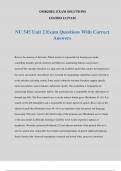Exam (elaborations)
NU 545 Unit 2 Exam Questions With Correct Answers
NU 545 Unit 2 Exam Questions With Correct
Answers
Review the anatomy of the brain. Which portion is responsible for keeping you awake,
controlling thought, speech, emotions and behavior, maintaining balance and posture? -
answerThe reticular formation is a large network of diffuse nuclei that c...
[Show more]
Preview 4 out of 32 pages
Uploaded on
October 18, 2024
Number of pages
32
Written in
2024/2025
Type
Exam (elaborations)
Contains
Questions & answers
Institution
NU 545
Course
NU 545
$11.49
100% satisfaction guarantee
Immediately available after payment
Both online and in PDF
No strings attached
©SIRJOEL EXAM SOLUTIONS




